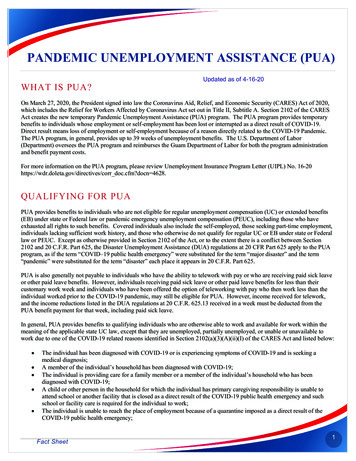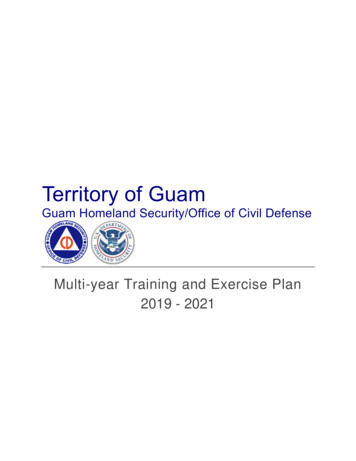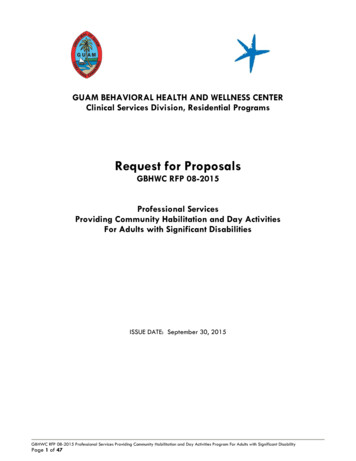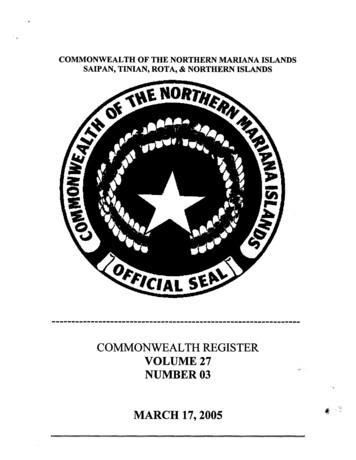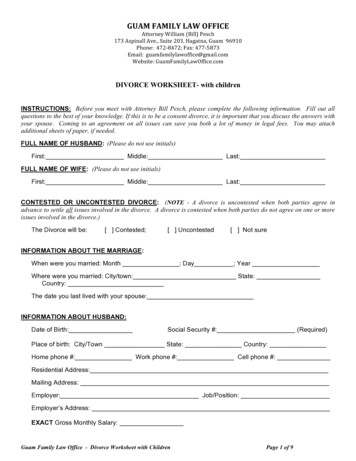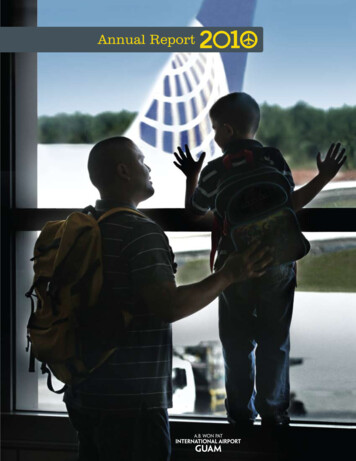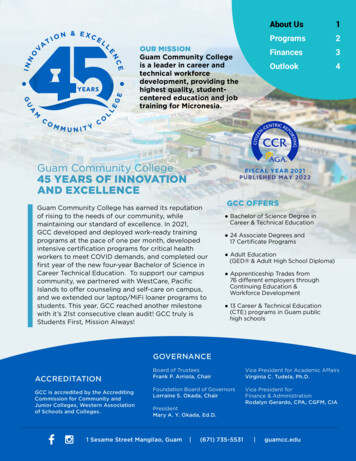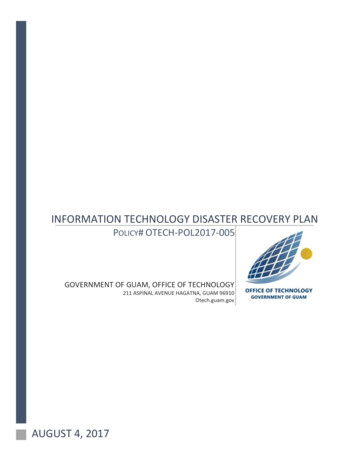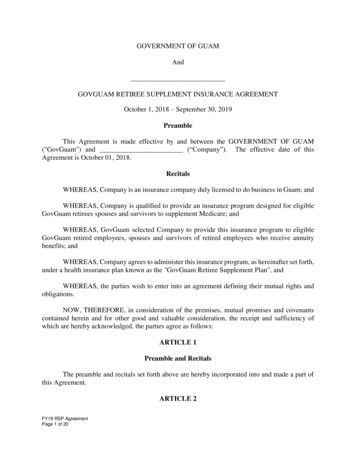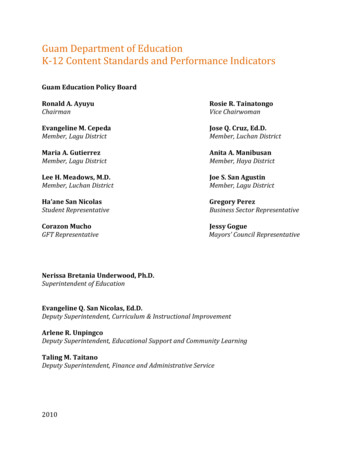
Transcription
Guam Department of EducationK‐12 Content Standards and Performance IndicatorsGuam Education Policy BoardRonald A. AyuyuChairmanRosie R. TainatongoVice ChairwomanEvangeline M. CepedaMember, Lagu DistrictJose Q. Cruz, Ed.D.Member, Luchan DistrictMaria A. GutierrezMember, Lagu DistrictAnita A. ManibusanMember, Haya DistrictLee H. Meadows, M.D.Member, Luchan DistrictJoe S. San AgustinMember, Lagu DistrictHa’ane San NicolasStudent RepresentativeGregory PerezBusiness Sector RepresentativeCorazon MuchoGFT RepresentativeJessy GogueMayors’ Council RepresentativeNerissa Bretania Underwood, Ph.D.Superintendent of EducationEvangeline Q. San Nicolas, Ed.D.Deputy Superintendent, Curriculum & Instructional ImprovementArlene R. UnpingcoDeputy Superintendent, Educational Support and Community LearningTaling M. TaitanoDeputy Superintendent, Finance and Administrative Service2010
TABLE OF CONTENTSEXECUTIVE SUMMARY iOVERVIEW . ii – viiiACKNOWLEDGEMENTS ix – xiCONTENT STANDARDSA. Educational Technology 1 ‐ 48B. Fine Arts 49 ‐ 197C. Health . 198 ‐ 289D. Language Arts/Reading 290 ‐ 458E. Mathematics 459 ‐ 547F. Physical Education 548 ‐ 611G. Science 612 ‐ 684H. Social Studies 685 ‐ 775I. World Languages 776 – 823APPENDICESA. Content Area Specialized Teachers (CAST) Training. 825 ‐ 826B. References and Resources . 827
EXECUTIVE SUMMARYGoal 2 of the DOE District Action Plan states that all Department of Education students willsuccessfully progress from grade to grade and from one level of schooling to another in order tomaximize the opportunities to successfully graduate from high school.In May 2003, the Guam Education Policy Board adopted the Guam Department of EducationDistrict Action Plan (DAP) which establishes the directions and details for improving academicperformance. Standards and Assessment, one of seven components of the DAP focuses onwhat is needed to be done to increase student achievement as students progress from grade tograde and across each content area.A major activity in the current District Action Plan includes the review and revision of the GuamDepartment of Education (Guam DOE) K‐12 Content Standards and Performance Indicators toreflect current educational practices, national standards and what the local community believesare valuable and necessary for students to be competent, productive, and responsible citizensin society and in the world.Through the support of Superintendent Nerissa B. Underwood, Ph.D., the revision of the K‐12Content Standards and Performance Indicators began in February 2009 with leadershipguidance by the Pacific Resource for Education and Learning (PREL) and a cadre of certified andexperienced teacher leaders from the elementary, middle and high schools.The review and revision is reflected in the content areas of English Language Arts/ Reading,Mathematics, Science, Social Studies, Fine Arts, World Languages, Health, Physical Education,and Educational Technology. These revised content standards and performance indicatorsreflect a curriculum that is detailed, explicit, and manageable for teachers to effectively teachand students can successfully learn. They are academically rigorous because they create highexpectations for all students, yet are balanced with the resources currently available or plannedfor in the near future.The Guam DOE K‐12 Content Standards and Performance Indicators are the district’s adoptedcurricula and teachers are expected to create their instructional units and lesson plans thatfocus on these expectations.This document meets the requirements of the Guam DOE District Action Plan, reflects currenteducational practices, and is aligned with the National Standards in the content areas.i
OVERVIEWThe following is the historical chronology describing the process used in revising the K‐12 ContentStandards and Performance Indicators.HistoryIn 1996, the draft of the K‐12 Content Standards and Performance Indicators was developed toinitiate standards‐based education in the Department of Education. The standards reflectededucational best practices and alignment to National Standards in all content areas. In January1999, the Board of Education adopted the K‐12 Content Standards and Performance Indicatorsin the areas of Mathematics, Science, Social Studies, Language Arts and Reading, Visual andPerforming Arts, World Languages, Health, Physical Education, Business/Marketing, andComputer Education. While these standards were used to guide the development of effectiveinstructional plans, they have not been updated in over ten years.In March 2009, the project began to review and revise the K‐12 Content Standards andPerformance Indicators for nine content areas in English Language Arts/Reading, Mathematics,Science, Social Studies, Fine Arts, World Languages, Health, Physical Education, and EducationalTechnology. The process was facilitated by the Pacific Resources for Education and Learning(PREL) in collaboration with a cadre of certified and experienced teacher leaders from theelementary, middle and high schools. The final draft revisions, which included input fromstakeholders, was completed in December 2009. Following the last revisions, the final draftstandards document was sent out to the schools for comment by the teachers and schooladministrators. A majority of GDOE Teachers endorsed the revised Content Standards andPerformance Indicators.The draft Standards was then sent to the Joint Board Union Curriculum Textbook Committee fortheir endorsement and was subsequently submitted to the Curriculum, Special Education,Textbook Sub‐Committee of the Guam Education Policy Board.Process SummaryComplying with the District Action Plan, the Superintendent of Education initiated the long,overdue review and revision of the K‐12 Content Standards and Performance Indicators bycharging the Division of Curriculum & Instruction to oversee the process. A Request forProposal was published to acquire the specific services of experts in the development ofContent Standards that reflect current best practices and alignment with National Standards.The bid award was given to the Pacific Resources for Education and Learning (PREL) after areview and approval of their qualifications. A cadre of teacher leaders was then established torepresent teachers in all grades in the content areas. The teachers were required to have acurrent teaching certificate and at least 3 years of classroom experience in the gradeii
level/content area. Many teachers were members of the Content Area Specialized Teachers(CAST) who had specialized training in their respective content area, pedagogy and leadershipskills and who are required to provide staff development training to their respective colleagues.( See appendix A for details of CAST training).PREL curriculum/content specialists and the Guam DOE teachers worked collaboratively for manymonths following a rigorous process to review and develop the revised K‐12 Content Standardsand Performance Indicators.Review and Revision ProcessPREL began communication with Guam DOE to finalize a work plan and develop a schedule ofactivities immediately upon final contract approval in mid‐January, 2009. A series of meetings,including the Superintendent, Deputy Superintendent for Curriculum and Instruction andImprovement and C&I staff, were held on Guam during the week of February 22, 2009 tofinalize the work plan.After discussions with Guam DOE, PREL used two nationally‐recognized reports on state standardsas the basis for determining model content standards for purposes of comparison reportsbetween national standards, exemplary state standards, and the 1996 Guam DOE standards.“National” content standards in the respective content areas were also included in thesynthesis and comparison. The national reports used were Sizing up State Standards 2008,published by the American Federation of Teachers (AFT), and The State of Standards 2006,published by the Fordham Foundation. In addition to being used to identify model standards,their review criteria, particularly those in the AFT report, were shared with the respectivereview and revision team to inform their thinking as they carried out their work.Below is a list of national standards and selected exemplary standards for each of the revisedcontent standard documents. What follows are excerpts from the content area comparisonreport with rationale for why certain states were selected and used for model exemplary statestandards.English Language Arts/ Reading – National English Language Arts Standards from theInternational Reading Association (IRA)/ National Council of Teachers of English (NCTE) andstandards from Indiana state.Both Sizing Up State Standards 2008, published by the American Federation of Teachers (AFT),and The State of Standards 2006, published by the Fordham Foundation, identify Indiana ashaving high‐quality standards for the English language arts. Indiana rated the highest of all thestates for model ELA standards.Mathematics – Principles and Standards for School Mathematics from the National Council ofTeachers of Mathematics (NCTM) and standards from Indiana and California states.This report compares the Guam DOE K–12 mathematics standards with the current NationalCouncil of Teachers of Mathematics (NCTM) standards and the mathematics standards of theiii
states of Indiana and California . The choice of the states of Indiana and California were basedon two standards evaluation documents in which these states ranked near the top in bothratings.Science – National Science Education Standards from the National Research Council (NRC) andstandards from Indiana state.Sizing Up State Standards 2008, published by the American Federation of Teachers (AFT), andThe State of Standards 2006, published by the Fordham Foundation, identify Indiana as havinghigh quality standards for science. These standards rate among the highest of all the states formodel science standards. Indiana was also one of the few states that scored high in the 2000and 2005 analyses showing consistency of quality over a period of time.Social Studies – Curriculum Standards for Social Studies from The National Council of SocialStudies (NCSS) and standards from Massachusetts state.Both Sizing up state standards 2008, published by the American Federation of Teachers (AFT),and The state of standards 2006, published by the Fordham Foundation, identify Massachusettsas having high quality standards for the Social Studies. They and Virginia rate the highest of allthe states for model SS standards.Fine Arts – The Arts Edge National Standards for Arts Education and the Visual and PerformingArts Content Standard for the California Public Schools.When comparing Guam DOE to California and National standards, it was found that the maindifference between these standards was in the way they are organized. A study ofapproximately half of the state standards reveals that most states use a framework that followswork and research called Discipline‐Based Arts Education written in the 1980s by the GettyFoundation. California was chosen as a comparison state because it was similar to the originalGetty work, and many of the writers were active in designing the original Discipline‐Based ArtsEducation Framework.Health Standards – The Joint Committee for National School Health Education Standardsdeveloped guidelines for school health standards with a committee made up of representativesfrom the Association for the Advancement of Health Education, the American Public HealthAssociation, the American School Health Association, and the Society of State Directors ofHealth, Physical Education, and Recreation.Physical Education – National Physical Education standards from the National Association forSport and Physical Education (NASPE) and standards from Indiana state.The State of Standards 2006, published by the Fordham Foundation, rates Indiana andCalifornia as having the highest overall academic standards in the nation. While PE was not oneiv
of the five subjects identified by the Fordham Foundation, a high level of clarity, rigor, andappropriate content are key components of exemplary standards in all content areas. Indianaand California revised their standards in 2008 and are closely aligned to the National Standardsfor Physical Education.World Languages – Standards for Foreign Language Learning: Preparing for the 21st Centuryfrom the American Council in the Teaching of Foreign Languages (ACTFL) and standards fromthe Indiana state.The Indiana Department of Education reviews and updates the standards for each grade level ineach subject area at least once every 6 years, in an effort to maintain high‐quality academicstandards. Indiana teachers, community members, and content experts at the university levelcollaborated to draft the 2007 Indiana Academic Standards for World Languages, whileoperating under the state’s mandate to devise standards that are “world‐class, clear, concise,jargon‐free, and by grade level”.Educational Technology –National Educational Technology Standards for Students (NETS*S),from the International Society for Technology in Education (ISTE) and Washington StateEducational Technology Standards.The International Society for Technology in Education (ISTE) is the leading institution ineducational technology, both in the U.S. and internationally, and their standards for students,teachers, and administrators are widely referenced and used in state standards development.The NETS*S standards used in this comparison report were published by ISTE in 2007. These arean updated version of the original NETS*S standards that were published in 1998.Washington State Educational Technology StandardsThe Washington state educational technology standards were chosen for this comparisonreport because they were updated recently, in December 2008. Their standards developmentprocess represents a relevant and updated vision of educational technology standards at a statelevel. While many U.S. states have not published revised standards based on the revisedNETS*S, Washington state has been through a thoughtful process of developing neweducational technology standards and mapping them with the revised national standards.The PREL facilitators for each of the nine content areas met, either in person or through videoteleconferencing, with the teachers that would make up the review and revision team in lateApril. These meetings focused on the key findings of the respective synthesis and comparisonreports.Each of the teacher leaders involved in the review and revision process was asked to return totheir school sites and interview other teachers and stakeholders to identify priority issues to beaddressed in the revision process as part of preparation for the May working sessions. Thev
input gathered through teacher interviews and other stakeholders was augmented withinformation from a survey of approximately 700 teachers carried out in March 2009.Teacher training on the development and writing of content standards and performanceindicators was completed on Saturday, May 09, 2009 for the content areas of Language Arts/Reading, Social Studies, World Languages, Technology and Physical Education. The sametraining was held for the rest of the content areas‐ Math, Science, Health, and Fine Arts onSaturday, May 16, 2009. This training was mandatory for all teachers involved in the revisionprocess because the new knowledge gained was directly applied to each of the content areas.Teachers were trained on the goals of standards revision, procedures, next steps, and glossaryof terms. Most of their training time was devoted to practicing how to write performanceindicators.The goals for the standards revision included 1) rigor: the standard’s ability to measure againstother standards across the nation; 2) depth: the levels of cognition, the affective levels and thepsychomotor levels – the level of skill students are expected to produce; 3) breadth: contentcoverage, how wide of a scope is being covered in that area; and, 4) coherence: how theyprovide seamless transition.The decisions made by the cadre included the following 1) determining essential and corecontent; 2) determining reasonable and achievable indicators; 3) standard developmentacross the grades; 4) consistency of performance indicators with content standards.The cadre determined whether the standards were appropriate and sufficient and ensured thatthe standards were vertically articulated (what is expected from grades K‐12) and horizontallyarticulated (what is expected from students) across the grade.While PREL facilitators and teacher teams approached the completion of their first draft ofrevised standards some teams faced challenges. For content areas that were presented withchallenges, the PREL facilitators continued support of the teacher cadres to revise the standardsand performance indicators via email, phone conference, or subsequent face to face meetings.PREL facilitators continued communication with their teacher revision teams until the draftstandards and performance indicators for their respective content area was completed.In consultation with the GDOE Division of Curriculum and Instruction, a calendar wasestablished to solicit feedback on the draft standards from all interested persons from July 29,2009 to August 12, 2009. PREL designed a web‐based survey instrument to obtain feedbackusing online survey software from SurveyMonkey.com. The online survey was posted on PREL’swebsite and the Guam DOE website. Hard copies of the first draft and survey tool were alsoavailable at the PREL Guam Service Center and Guam DOE Curriculum and Instruction office forthose who did not have access to the internet.After the agreed upon two week period, the Guam DOE Superintendent determined that anadditional two weeks was necessary to acquire more participation in the survey. As a result,vi
over a four week period from July 29, 2009 to September 07, 2009 was given for all interestedpersons to provide feedback and input on the draft.The survey results were aggregated by PREL immediately after the close date of September 07,2009. Each PREL facilitator shared the summary of results with the teacher revision cadres(who participated in developing the drafts) and the Division of Curriculum and Instruction. Eachcontent area teacher revision cadre analyzed the summaries and made modifications based onthe results and comments as well as other input received along the way.Survey data was collected from 115 respondents to the online survey along with other types ofinput collected to help inform the draft standards. It is important to note that although theonline survey indicated total responses from 115 participants, the Division of Curriculum andInstruction and PREL have been informed by some respondents that they were answering onbehalf of more than one teacher. One such example would be a high school department chairanswering on behalf of five teachers.On September 17, 2009, a stakeholders meeting was held during a Guam Education PolicyBoard work session to review the information gathered from the comparison reports and inputreceived from teacher leaders. An update and progress report on the project was presented bythe Division of Curriculum and Instruction. PREL’s focus was on summarizing 1) therecommendations for all nine content areas based on the comparison reports completed anddisseminated on April 23, 2009 to May 05, 2009 and 2) the feedback gathered from teacherswho were part of the review and revision teams.Recommendations made by those present at the session, particularly board members, wereaddressed by the Curriculum and Instruction Office before the final drafts were submitted toGuam DOE.The final drafts of the Guam DOE Revised K‐12 Content Standards and Performance Indicatorswere completed and submitted to the Division of Curriculum and Instruction in December 2009.In late December 2009, electronic and hard copies of the draft were sent out to all the schools.School administrators were asked to have their teachers review the draft and to submit theircomments to the Division of Curriculum and Instruction. In addition to these copies provided tothe schools, hard copies were also made available at the Division of Curriculum and Instructionand the PREL office for a final public review and feedback. Electronic and hard copies were alsogiven to the Guam Education Policy Board for review and comments.Following the teacher reviews and endorsements, the draft was submitted to the Joint BoardUnion Curriculum Textbook Committee for their review. All members of the committeeendorsed the revision after evaluating and analyzing the results of the teacher endorsements.The draft was then submitted to the Curriculum, Special Education and Textbook Sub‐Committee of the Guam Education Policy Board.vii
Highlights of the Revised Content Standards and Performance IndicatorsThe content standards and performance indicators were revised and refined to reflect current researchwhich includes alignment with current national standards and the criteria from the American Federationof Teachers (AFT) for good standards. The highlights below indicate the differences between the revisedstandards and the current standards: There is a standard and consistent format for all content areas.Clear definitions for each standard in all content areas were added.Standard statements were revised to express K‐12 goals.Performance indicators were aligned with standard goals (horizontal alignment)Performance indicators were aligned to each grade level (vertical alignment)Grade‐level performance indicators and examples added clarity and detail for teachers. (CurrentScience standards are organized by grade clusters for both middle and high school, 6‐8 and 9‐12. The revised Middle school standards are broken down by grade and in the high school thestandards are broken down by course.)End of grade expectations were added for grades K‐8 to ensure consistency for all content areas.End of course expectations for high school core curriculum were revised and/or added for allcontent areas.Most subject areas were re‐organized by strands and/or themes to help organize the content forteachers.National Standards and State Exemplary Standards were incorporated into the revisedStandardsActivities Related to the Revised Content StandardsFollowing the adoption of the revised K‐12 Content Standards and Performance Indicators, iswill be a series of related activities.PREL will facilitate a training of trainers to assist in preparing the teacher cadre members andother representatives to conduct revised standards orientation and training for the district.Following a one‐year period, C and I staff will solicit implementation feedback from teachers.Another upcoming related activity will be the alignment of the revised standards with the GuamDOE adopted textbooks and SAT 10. Also, any future text program adoption will also be based onalignment with these approved Guam DOE standards in each content area.Once the standards are adopted, the development of the criterion‐reference assessmentsbased on the adopted standards will begin. Other related activities include curriculumalignment to the standards and curriculum guide development tied to the revised standards.It is anticipated that once the revised Guam DOE Content Standards are adopted, the aboverelated activities will provide support for teachers to effectively teach to the standards and helpstudent to meet those standards. They will also provide a mechanism‐ through the criterion‐referenced assessments ‐ to measure student achievement towards those standards.viii
ACKNOWLEDGEMENTSSpecial thanks to the members of the Content Area Cadres who led the work in reviewing andrevising the K‐12 Content Standards and Performance IndicatorsMembers of the Content Area CadresEducational Technology CadreMarie Juvy G. CarinoL.P. Untalan MiddlePatricia L. DiegoGeorge Washington HighJessica Rose P. FejeranF.B. Leon Guerrero MiddleCina M. Hume‐ForbesC.L. Taitano ElementaryKeith QuiambaoSimon Sanchez HighFine Arts CadreDolores AtaligRonald CanosWin CarterDawn MakaNicole PerezTalafofo ElementarySimon Sanchez HighSouthern HighAsTumbo ElementaryCapt. H.B. Price ElementaryHealth CadreJay AntonioFrancisco De LeonJennifer A. JoseJeffrey M. MalinaoTheresa L. MorenoMary B. NolteCecilia P. VillaverdeJames SchmidtGeorge Washington HighGeorge Washington HighFinegayan ElementaryFinegayan ElementaryOceanview HighOkkodo HighP.C. Lujan ElementaryM.A. Ulloa ElementaryLanguage Arts/Reading CadreJulie FlisV. Benavente MiddleKatherine FloresF.B. Leon Guerrero MiddleAudrey M. LanadaAsTumbo ElementaryJudy E. ManibusanP.C. Lujan ElementaryRosa P. O’MallanCapt. H.B. Price ElementaryDina M. SantosOkkodo HighTrittia M. TerbioSimon Sanchez HighJoycelyn R. ValenzuelaOkkodo HighMathematics CadreMary Annie M. AngelesGeorge Washington Highix
Beatriz A. CamachoVicky CruzNatasha Dela CruzAlpha EspinaRyan FloresMichelle S. MasnayonCynthia RowlandRichard L. VelascoMary Jean VigilanteGeorge Washington HighAs Tumbo ElementaryInarajan MiddleGeorge Washington HighSimon Sanchez HighL.B. Johnson ElementaryD.L. Perez ElementaryF.B. Leon Guerrero MiddleGeorge Washington HighPhysical Education CadreGeraldine U. FranciscoBarbara L. GilmanJames LujanCapt. H.B. Price ElementaryJohn F. Kennedy HighOkkodo HighScience CadreMary BiasAileen CanosElizabeth CruzVincent EblacasMaria Lourdes FelipeIrene MafnasMarie C. MandapatJacqueline PabloBruce PattersonF.B. Leon Guerrero MiddleF.B. Leon Guerrero MiddleGeorge Washington HighL.P. Untalan MiddleAs Tumbo ElementaryF.B. Leon Guerrero MiddleLiguan ElementaryGeorge Washington HighV. Benavente MiddleSocial Studies CadreEleanor A. BlasMarcia CruzMelissa A. FloresAmy MartinOlivia L.G. VelasquezP.C. Lujan ElementaryP.C. Lujan ElementaryOkkodo HighF. B. Leon Guerrero MiddleB.P. Carbullido ElementaryWorld Languages CadreLinda A.T. EdwardTeresita C. FloresUpi ElementaryOkkodo Highx
Pacific Resource for Education & Learning (PREL) Program SpecialistsPatricia Brown, M.Ed.Sonia Evenson, M.PHMargaret Ho, Ed.D.Pamela Legdesog, M.Ed.Ellen Miyasato, Ph.D.Gene Dydasco, M.Ed.Asuncion Guerrero, M.Ed.Leslie Lee, Ph.D.Marilyn Low, Ph.D.Lori Phillips, Ph.D.Curriculum & Instruction DivisionEvangeline Q. San Nicolas, Ed.D. – Deputy SuperintendentCathy BayonaCarl J. BlasSylvia T. CalvoDavid CruzRosario FernandezFaye Camacho KaibleEsther L.G. KeoneJeanette TaitanoProgram CoordinatorProgram CoordinatorSchool Program ConsultantProgram CoordinatorSupport StaffSchool Program ConsultantSchool Program ConsultantProgram Coordinatorxi
EDUCATIONAL TECHNOLOGYGUAM DEPARTMENT OF EDUCATIONREVISED STANDARDS FOREDUCATIONAL TECHNOLOGY1
EDUCATIONAL TECHNOLOGYThe Content Standards for the Guam Department of Education (GDOE) describe the expectations for student learning andachievement in grades K –12 in mathematics, language arts, science, social studies, world languages, physical education,education technology, fine arts, and health education.These standards set challenging and rigorous expectations at each grade level. These expectations were arrived at through a reviewof national standards, exemplary standards from other states, and input from teacher leaders in Guam. In addition, they provide moreclarity to support all students in developing skills; deepening their understanding of concepts and processes; and utilizing theirproblem-solving, reasoning, and communications abilities. For students to develop this deeper level of understanding, theirknowledge must be connected not only to a variety of ideas and skills across topic areas and grade levels in each content area, butalso to other subjects taught in school and to situations outside the classroom.Our world is changing rapidly. In order for our students to compete in a global economy, to make informed decisions about their lives,and to contribute to their families and their communities, they need the knowledge and skills for a 21st century workplace. Thestandards provide opportunities for students to develop skills in problem solving, inquiry, technology, teamwork, and creativity.The revised content standards are the first step in improving learning for all students in the GDOE. The standards will stronglysupport teachers as they prepare our students for graduation, college, and the workforce. Teachers will use the standards to designinstruction and to make instructional decisions regarding content and pedagogy. The standards serve as g u i d e s for curriculumdevelopment, including course syllabi and pacing guides, as well as for formative and summative assessment.Standards Statements broadly describe the knowledge and skills we expect our students to have at the end of their schooling.These statements define our expectations for what is important for students to learn, serve as guides for curriculum and instruction,and are the basis for all assessment.Performance Indicators describe what students should know and be able to do (related to each standard) at the end of a gradelevel or at the end of a course. These statements describe progress toward meeting standards in a coherent progression fromkindergarten through grade 12.Examples accompany many of the performance indicators. These provide a context and fuller understanding of the expectation.Additionally, some content standards may feature two organizing descriptors:Strands are overarching organizers for standards. They are typically one or two words in length.Topics or Themes are unifying descriptors for performance indicators.2
EDUCATIONAL TECHNOLOGYIdentifying Performance IndicatorsEach per
Educational Technology -National Educational Technology Standards for Students (NETS*S), from the International Society for Technology in Education (ISTE) and Washington State Educational Technology Standards.
